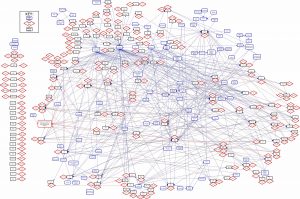While hypertext does not change the physical words on the page, it does impact the order in which they are read. This allows for an infinite number of reader interpretations, since the proximity of any two text excerpts will create an automatic association. In an ideal model, hypertext will use trails to create natural links between items, “connecting information by linking two units together, anticipating hyper-text paths” (Barnet & Tofts). Once these two-unit connections are established, a reader can trailblaze through a seemingly endless trail of links and associations.
There are many benefits to hypertext association. With hypertext’s “sense of unending,” readers are able to engage with the text as long and as deeply as they wish (Barnet & Tofts). This means there is no end to the universe created by the text, not like there is with a novel or a movie, both of which have a limited scope of interaction since their plots, settings, and characters are pre-defined and delineated. Like chapter breaks in a novel, hypertext works to create a sense “of becoming, of ongoingness, of imminence,” always pushing the user onto the next link and the next text (Barnet & Tofts). This creates a level of urgency that a printed text would be hard-pressed to achieve. I also agree with Jordyn and Sarah that this characteristic of hypertext can be very useful for research. A large hyperlinked filing system of texts would not only create new associations between texts, but also highlight existing ones that we may not have noticed on our own.
Interestingly enough, though the easiest version of hypertext occurs on a digital platform, I would like to make the argument that it is possible (though extremely complicated) to have a hypertext in print. I offer Vladimir Nabokov’s Pale Fire as an example. “Pale Fire is presented by demented narrator Charles Kinbote as a 999-line poem which he is annotating in the commentary that forms the bulk of the book. The novel has a storyline that progresses during sections of the foreword and commentary, but the reader is often directed back to lines from the poem or sent to other annotations (“see also note to line 894”). Subtler elements of the story emerge only through cross-references” (Pitzer).

However, while there are many benefits to hypertext, this is reliant on an ideal system and execution. For print, this means issues of reader engagement and willingness to flip back and forth to make these connections. When readers can see all the possible connections, rather than focusing on the two occuring at the moment, it is easy to get overwhelmed rather than emersed. Furthermore, in terms of digital hypertext, we’ve seen that technology malfunctions, that links break and documents are lost and copyright and authorship are misplaced from a text. Though there are dreams of the perfect Xanadu filing system, we have not yet achieved such a hypertext system “where all quotations within an article would stay connected to their source documents, and readers could click through to the original context of a citation. New changes could be made by authors without breaking any links, and anyone could connect comments to any page” (Barnet & Tofts). Even a working system, once established, will be hard-pressed to keep up with new content. “The collective record is expanding, information is getting more complex, and we are not equipped to manage the mess” (Barnet & Tofts). While google and other search engines have found ways of using volunteers to categorize and shift through untagged data, this will likely not be enough to support a large-scale hypertext filing system. At this point, our hypertext projects are still limited in size and scope.
Word Count: 623
Works Cited:
Barnet, Belinda, and Darren Tofts . “Too Dimensional: Literary and Technical Images of Potentiality in the History of Hypertext.” A Companion to Digital Literary Studies, www.digitalhumanities.org/companion/view?docId=blackwell/9781405148641/9781405148641.xml&chunk.id=ss1-5-9&toc.depth=1&toc.id=ss1-5-9&brand=9781405148641_brand.
Pitzer, Andrea. “Nabokov’s Pale Fire as Hypertext.” The Secret History of Vladimir Nabokov, 20 Feb. 2013, nabokovsecrethistory.com/news/pale-fire-as-hypertext-nabokov-rowberry/#.WtFP6dPwa9a.
